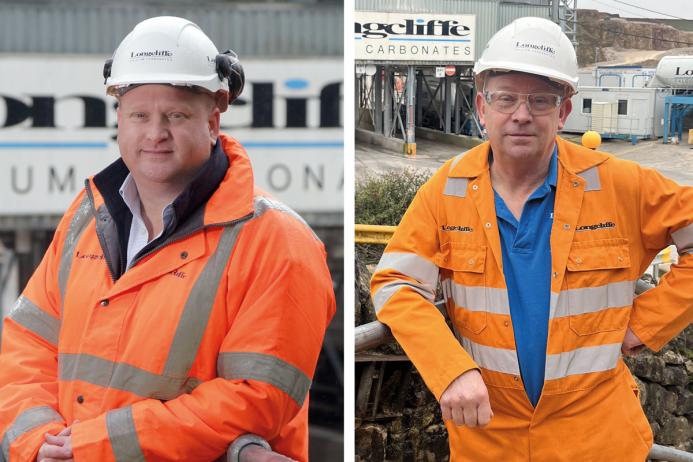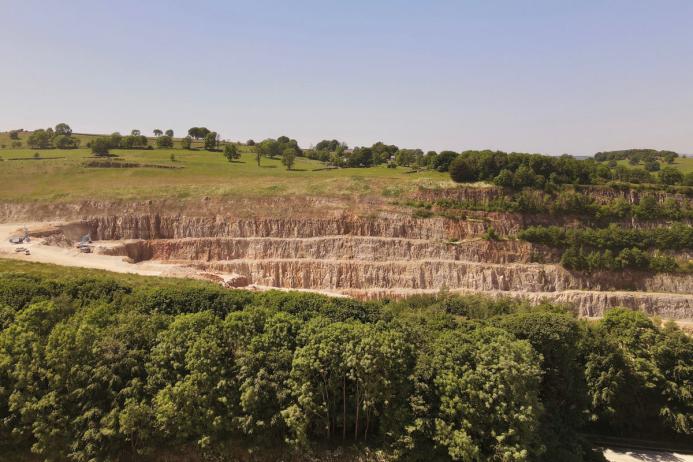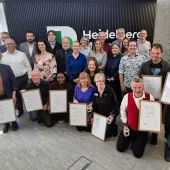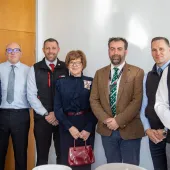Longcliffe's Rollover Slopes

First published in the May 2024 issue of Quarry Management
The evolution of quarry face restoration
Knowledge of restoration, landscaping, biodiversity gain, and visual impact minimization have developed and combined over the decades to ensure quarrying companies such as Longcliffe can ‘give back land’ in the most positive way possible.
Longcliffe Quarries Ltd group managing director Paul Boustead explained more about the company’s experience at its sites in Derbyshire: ‘The way that a worked-out quarry is finished and restored has evolved over the years to increasingly enhance the landscape and encourage biodiversity.
‘Quarry restoration approaches began with leaving quarry benches well alone – allowing them to regenerate without significant proactive work by the quarry operator. The next stage was to plant trees along the lines of the benches to provide some green covering and mask the edges. Leading on from this was the approach of breaking up the horizontal lines of the benches with diagonal ‘cuts’ to prevent the visual look from being too regimented.
‘Finally, around 15 years ago, we started softening the edges of the benches by creating ‘rollover’ slopes. These are created by building up waste material – usually clay-bound limestone – to make the shape. The Longcliffe rollovers are designed to be mainly soft ‘rolling’ slopes of 1:2 gradient but the final ‘nose’ of the slope is more like 1:1 gradient to make it look more like the familiar shaped hills of the Derbyshire Dales.’
Rollovers are not just better visually but are safer with less risk of rockfall. However, whilst the outcomes are positive, the creation of rollover slopes is much more complicated to plan for and challenging to achieve in comparison with the previous styles of restoration.

Longcliffe development director Ian McDonald explained the rollover creation process in more detail: ‘We are always planning ahead to achieve the most positive progressive restoration of our quarries. In general, from a distance you can only see the top 10–20% of a quarry once it has been worked out. So, if that is the only area you can see, and you can reduce its visual impact, you have made a significant positive contribution to the local area and community. We wanted to avoid the ‘letterbox’ view which is where you can have green landscape meeting a long straight brown line of a quarry bench.
‘Back in the 1970s our planning permissions included the requirement to restore quarry perimeters by planting trees along the benches. Fast-forward to the 2000s when we put the application in for the original Aldwark extension in our Brassington Moor Quarry. By this time, we needed to come up with a way to achieve a gentler final landform shape so that views from nearby areas of Ible and Bonsall were undisturbed. The proposed restoration included the creation of rollover slopes.
‘It has taken years of teamwork between quarry planners, biodiversity experts and, importantly, highly skilled excavator operators to move material and plant the resulting slopes while the normal quarry operations continued. We used waste material as the base for the rollover, but then laid soils over the top to create a growing membrane for local species to thrive. What we create is a calcareous grassland to support typically short and hardy plants such as grasses and herbs such as clover.’
Mr McDonald concluded: ‘The establishment of rollover slopes as a method of restoration is a lot more work than bench planting, but in my personal experience it is also a lot more rewarding.’
Paul Boustead added: ‘At Longcliffe you can already see the success of the rollovers established after the company’s last quarry extension and restoration in Aldwark in 2008. The rollovers created have enabled the edges of the former quarry area to blend back into the landscape and be ‘softer’ on the eye – some would say invisible - from a distance.’

These rollovers offer more environmental benefits:
They make a good use of what would otherwise be waste material (for instance, clay-bound calcium carbonate which cannot be processed)
They encourage more biodiversity – in the current Aldwark restored area, where the land is planted with field grass and wildflowers, the company has identified bats, stoats, voles, and kestrels among other species.
The experience Longcliffe have built in creating rollover slopes has delivered a successful visual impact reduction track record and, at the same time, has helped the company enhance local biodiversity – one of its key sustainability goals.
In March 2024 Longcliffe submitted a planning application to Derbyshire County Council for permission to extend Brassington Moor Quarry into a new area known as Aldwark South. If the company is granted planning permission, it will build on this track record and apply the same restoration approach to the progressive restoration of this area.
Mr Boustead concluded: ‘Rollover slopes are the best way to ‘give back the land’
to the local landscape once quarry operations are finished. The rollover slopes form an important part of Longcliffe’s commitment to respecting the local landscape and environment both for now and the future.’
Subscribe to Quarry Management, the monthly journal for the mineral products industry, to read articles before they appear on Agg-Net.com








